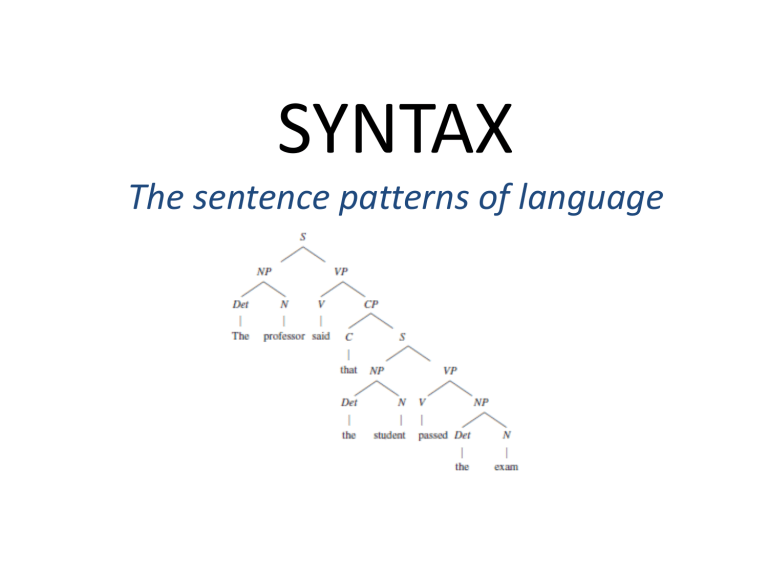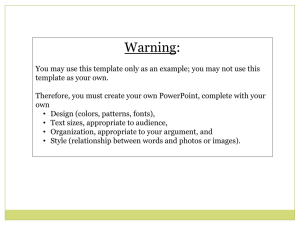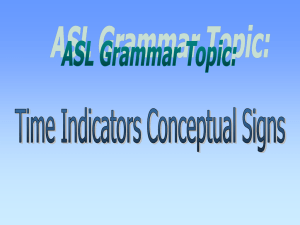SYNTAX The sentence patterns of language

SYNTAX
The sentence patterns of language
INTRODUCTION
• any speaker of any human language can produce and understand an infinite number of sentences.
INTRODUCTION
• All languages have mechanisms of this sort that make the number of sentences limitless.
• the sentences of a language cannot be stored in a dictionary format in our heads.
• Rather, sentences are composed of discrete units that are combined by rules.
• This system of rules explains how speakers can store infinite knowledge in a finite space—our brains.
• The part of grammar that represents a speaker’s knowledge of sentences and their structures is called syntax.
• The aim of this chapter is to show you what syntactic structures look like and to familiarize you with some of the rules that determine them.
WHAT THE SYNTAX RULES DO
The rules of syntax combine words into phrases and phrases into sentences.
The rules specify the correct word order for a language.
Syntax describes the relationship between the meaning of a particular group of words and the arrangement of those words.
Syntax also specifies the grammatical relations of a sentence, such as subject and direct object.
WHAT THE SYNTAX RULES DO
Syntactic rules also specify other constraints that sentences must adhere to.
grammatical judgments are neither idiosyncratic nor capricious, but are determined by rules that are shared by all speakers of a language.
WHAT THE SYNTAX RULES DO
Sentences are not simply strings of words with no further organization.
Sentences have syntactic structures associated with them.
In (10) we see that the phrase ran up the hill behaves differently from the phrase ran up the bill, even though the two phrases are superficially
quite similar. For the expression ran up the hill, the rules of the syntax
allow the word orders in (10a) and (10c), but not (10b). In ran up the bill,
in contrast, the rules allow the order in (10d) and (10e), but not (10f).
WHAT THE SYNTAX RULES DO
Our syntactic knowledge crucially includes rules that tell us how words for groups in a sentence, or how they are hierarchically arranged with respect
to one another.
The captain ordered all [old men and women] off the sinking ship.
WHAT THE SYNTAX RULES DO
For sale: an antique desk for lady with thick legs and large drawers.
[a desk] [for lady with thick legs and large drawers]
[a desk for lady] [with thick legs and large drawers]
SENTENCE STRUCTURE
Sentences have a hierarchical organization; that is, the words are grouped into
natural units.
The child found a puppy
[the child] [found a puppy]
[the child] [[found] [a puppy]]
[[the] [child]] [[found] [[a] [puppy]]] tree diagram:
CONSTITUENCY TESTS
CONSTITUENT = A group of words that function together in a sentence.
The elephant snorted a bowl of peanuts.
• There is the intuition that the & elephant are more closely related than
peanuts and snorted.
• This intuition is captured with constituency.
CONSTITUENCY TESTS
Movement
CONSTITUENCY TESTS
REPLACEMENT
CONSTITUENCY TESTS
PRO-FORM REPLACEMENT
CONSTITUENCY TESTS
STAND ALONE TEST
CONSTITUENCY TESTS
CONSTITUENCY TESTS
CONSTITUENCY TESTS
PHRASE STRUCTURE TREES AND RULES
Phrase structure trees (PS trees, for short) are explicit graphic representations of a speaker’s knowledge of the structure of the sentences of his language.
PHRASE STRUCTURE TREES AND RULES
Each grouping in the tree diagrams of “The child found a puppy” is a member of a large family of similar expressions.
For example, the child belongs to a family that includes the police officer , your neighbor , this yellow cat , he , John , and countless others. We can substitute any member of this family for the child without affecting the grammaticality of the sentence, although the meaning ofcourse would change.
A family of expressions that can substitute for one another without loss of grammaticality is called a syntactic category
PHRASE STRUCTURE TREES AND RULES
The child , a police officer , John , and so on belong to the syntactic category noun phrase (NP)
NPs may function as the subject or as an object in a sentence. NPs often contain a determiner (like a or the ) and a noun, but they may also consist of a proper name, a pronoun, a noun without a determiner, or even a clause or a sentence.
PHRASE STRUCTURE TREES AND RULES
PHRASE STRUCTURE TREES AND RULES
PHRASE STRUCTURE TREES AND RULES
Words appear in trees under labels that correspond to their syntactic category
The larger syntactic categories, such as VP, consist of all the syntactic categories and words below that point, or node , in the tree.
The VP in the PS tree above consists of syntactic category nodes V and NP and the words found , a , and puppy.
Because a puppy can be traced up the tree to the node NP, this constituent is a noun phrase .
Because found and a puppy can be traced up to the node VP, this constituent is a verb phrase.
PHRASE STRUCTURE TREES AND RULES: domination
In discussing trees, every higher node is said to dominate all the categories beneath it.
S dominates every node.
A node is said to immediately dominate the categories one level below it.
VP immediately dominates V and NP, the categories of which it is composed.
Categories that are immediately dominated by the same node are sisters
V and NP are sisters in the phrase structure tree of “the child found a puppy.”
PHRASE STRUCTURE TREES AND RULES
A PS tree is a formal device for representing the speaker’s knowledge of the structure of sentences in his language, as revealed by our linguistic intuitions.
PS-RULES capture the knowledge that speakers have about the possible structures of a language a speaker’s knowledge of the permissible and impermissible structures exists as a finite set of rules that generate a tree for any sentence in the language.
PHRASE STRUCTURE TREES AND RULES
PHRASE STRUCTURE TREES AND RULES
PHRASE STRUCTURE TREES AND RULES
PHRASE STRUCTURE TREES AND RULES
PHRASE STRUCTURE TREES AND RULES
PHRASE STRUCTURE TREES AND RULES
PHRASE STRUCTURE TREES AND RULES
PHRASE STRUCTURE TREES AND RULES
Another option open to the VP is to contain or embed a sentence. For example,the sentence
“The professor said that the student passed the exam” contains the sentence “the student passed the exam.” Preceding the embedded sentence is the word that , which is a complementizer (C) . C is a functional category, like Aux and Det.
PHRASE STRUCTURE TREES AND RULES
CP stands for complementizer phrase. Rule 8 says that CP contains a complementizer such as that followed by the embedded sentence.
Other complementizers are if and whether in sentences like
I don’t know whether I should talk about this.
The teacher asked if the students understood the syntax lesson.
PHRASE STRUCTURE TREES AND RULES








